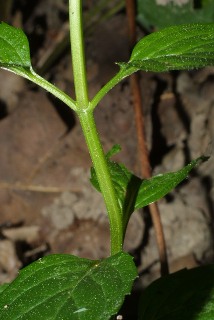Classification
The scientific name for peppermint (Mentha x piperita ) is derived from the name Mintha, a Greek mythological nymph who transformed herself into the plant, and from the Latin piper meaning "pepper."
 DOMAIN: Eukarya
(Eukaryotic)
DOMAIN: Eukarya
(Eukaryotic)
KINGDOM: Plantae (Plant)
SUBKINGDOM: Tracheobionta
(Vascular Plant)
SUPERDIVISION: Spermatohyta
(Seed Plant)
PHYLUM: Angiospermophyta
(Flowering Plant)
CLASS: Magnoliopsida (Dicotyledon)
ORDER: Lamiales
FAMILY: Lamiaceae (Mint Family)
GENUS: Mentha (Mint)
SPECIES: Mentha x piperita (Peppermint)
DOMAIN EUKARYA: The peppermint plant falls under the domain Eukarya because it is a multicellular organism with membrane-bound organelles including a nucleus.
KINGDOM PLANTAE: The plant kingdom is characterized by cell walls made of cellulose and a chloroplast that goes through the process of photosynthesis.
PHYLUM ANGIOSPERMOPHYTA: Peppermint is an angiosperm, meaning it produces flowers. They bloom from July through August, sprouting tiny purple flowers in whorls and terminal spikes. However, the plant is typically pruned to prevent flowering and increase leaf production.
CLASS MAGNOLIOPSIDA: Dicotyledons or 'Dicots' are characterized by six characteristics. The first characteristic is the seed. A dicot seed has two cotyledons or seed leaves in the embryo. Dicot flowers are found in multiples of four or five. The stem of a dicot is found having a ring shape compared to being scattered. Pollen has three pores in a dicot plant, while a monocot has only one. Dicot roots are known to have a main root. Lastly, the leaf veins of dicots are branching, not parallel.
 ORDER LAMIALES: This order is classified
using the following characteristics: an ovary composed of two
fused carpels, five petals fused into a tube, bilateral
symmetry, and four (or less) fertile stamens (the male organ of
a flower).
ORDER LAMIALES: This order is classified
using the following characteristics: an ovary composed of two
fused carpels, five petals fused into a tube, bilateral
symmetry, and four (or less) fertile stamens (the male organ of
a flower).
FAMILY LAMIACEAE: The mint family share characteristics including square stems, leaves that are usually opposite but sometimes whorled, are equal in size and shape and lack stipules (the appendages at the base of the leaves), the edges of leaves may be smooth, toothed, scalloped, and characteristic scents when crushed (oils in leaves) distinctive flavors of the particular species.
GENUS MENTA: Mentha refers to the true mints (fertile and not a hybrid). Some examples are Mentha aquatica, Mentha arvensis, Mentha longifolia, and Mentha suaveolens. Hybrid mints, like Mentha x piperita, are written with a 'x' between the genus and species name.
SPECIES MENTHA X PIPERITA : Mentha x piperita is a hybrid plant derived from the crossing of Mentha aquatic (water mint) and Mentha spicata (spearmint).